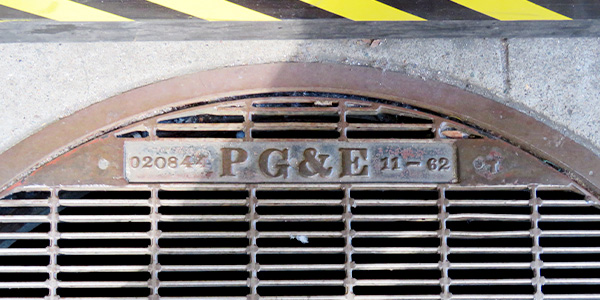
But PG&E reported GAAP losses of $3.73/share in the second quarter, driven mainly by $2.5 billion in costs to exit bankruptcy and help pay for the 2019 Kincade Fire.
The earnings call was led by PG&E Director and interim CEO Bill Smith, who replaced Bill Johnson after he retired June 30. (See PG&E Names New Board of Directors.)
It was the first live earnings report in many months. PG&E, one of the nation’s largest utilities, filed for bankruptcy in January 2019 following two years of devastating wildfires ignited by its equipment. It emerged from Chapter 11 reorganization July 1.
“Today’s call marks a milestone for us, and we’re excited to share our post-emergence vision for the coming years,” Smith said. “We’ve emerged from bankruptcy as a stronger company. The complex legal matters are now resolved, and major regulatory cases establishing our revenues are either approved or settled.”
Smith said PG&E plans to return to investment-grade status after credit ratings agencies reduced its corporate debt to junk bond status during bankruptcy.
Even in June, as the company prepared to exit bankruptcy, the three major ratings agencies — S&P Global Ratings, Fitch Ratings and Moody’s Investors Service — assigned sub-investment-grade status to billions of dollars in PG&E debt, including $4.75 billion in new debt it issued to help pay for its nearly $60 billion reorganization plan.
Share Price Lags
The company’s stock rose slightly during Thursday’s 11 a.m. ET earnings call from $9.12/share at the start of trading to $9.48 at 11:15 a.m., before falling back to $9.29 by 4 p.m.
PG&E’s share price has lagged since the COVID-19 crisis started in March. It fell further in June as the company prepared to issue more than $5 billion in new equity, diluting its existing stock value.
The company is hoping to recover billions of dollars in lost value.
A month before the Northern California wine country fires of October 2017, PG&E’s stock had hit a high of $70.64/share. It plunged as the utility’s equipment appeared the likely cause of most of the 21 major fires during dry, windy conditions in Napa and Sonoma counties.
The company’s stock fell further after it acknowledged one of its aging transmission lines likely started the Camp Fire in November 2018, killing 85 people and leveling much of the town of Paradise, Calif. The corporation pled guilty to 85 felony counts in December related to the fire. (See PG&E Sentenced; Bankruptcy Plan Approved.)
Shares hit a then-low of $7.23/share after the company announced it would declare bankruptcy and reached a historic low of $3.80 on Oct. 28, 2019, three days after another of its transmission line appeared to have caused the Kincade Fire, which tore through the Sonoma County wine region, burning nearly 78,000 acres and destroying 374 structures.
The California Department of Forestry and Fire Protection on July 16 said that its investigation had determined a PG&E high-voltage line running from a geothermal plant near the town of Geyserville had started the fire.
The company still faces lawsuits and a possible criminal investigation from the blaze. In its quarterly report to the U.S. Securities and Exchange Commission on Thursday, PG&E said its “financial condition, results of operations, liquidity and cash flows could be materially affected as a result of the 2019 Kincade Fire.”
Fire-prevention Efforts
With California’s late summer and fall fire season just around the corner, PG&E’s worst enemy would be a new fire started by its equipment. The ratings agencies said in June that the risk of another catastrophic wildfire was a primary reason for keeping PG&E’s credit rating so low.
In Thursday’s earnings report, Smith and other PG&E executives cited ongoing efforts to reduce the risks of wildfires, including grid hardening and enhanced weather monitoring.
PG&E said it is on track to meet the goals it laid out in its 2020 Wildfire Mitigation Plan, submitted to the California Public Utilities Commission.
The utility said it has completed more than half of the system-hardening work it committed to this year by undergrounding or installing stronger poles and covered conductor along 122 circuit miles, a small portion of its huge system.
PG&E owns 106,681 circuit miles of distribution lines and 18,466 circuit miles of transmission lines. More than 50% of its 70,000-square-mile service territory is in high fire risk areas.
The company also said it has completed 70% of its enhanced vegetation management program this year.
“PG&E has reviewed more than 1,200 miles of distribution and lower-voltage transmission lines and taken necessary action to trim or remove hazards and expand rights-of-way,” it said in a news release.
The utility said it fell behind on its “situational awareness” efforts because of supply-chain disruptions caused by the pandemic but still installed 144 weather stations and 60 high-definition cameras in fire-prone areas.
Advanced analytics and artificial intelligence are being added to its fire-prevention arsenal, PG&E said, along with technology from Australia that can de-energize a falling overhead line before it hits the ground, sparking dry vegetation.
The company has promised it will try to keep its public safety power shutoffs shorter and more limited geographically this fire season. Last year, the company shut off power to hundreds of thousands of customers, for as long as a week in some cases, prompting a public and political backlash. (See California Officials Hammer PG&E over Power Shutoffs.)
The company remains under threat of a government takeover should it fail to meet state safety requirements. (See Governor Signs PG&E ‘Plan B’ Takeover Bill.)
PG&E understands that vows to change, apologies and financial settlements with fire victims will no longer be enough, Smith said in a statement Thursday.
“We know that what’s needed now is action,” he said. “We will continue to work tirelessly to combat the growing threat of wildfires and keep our customers and communities safe.”




